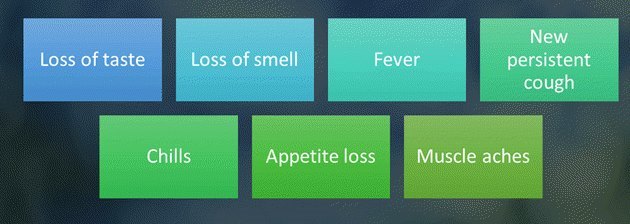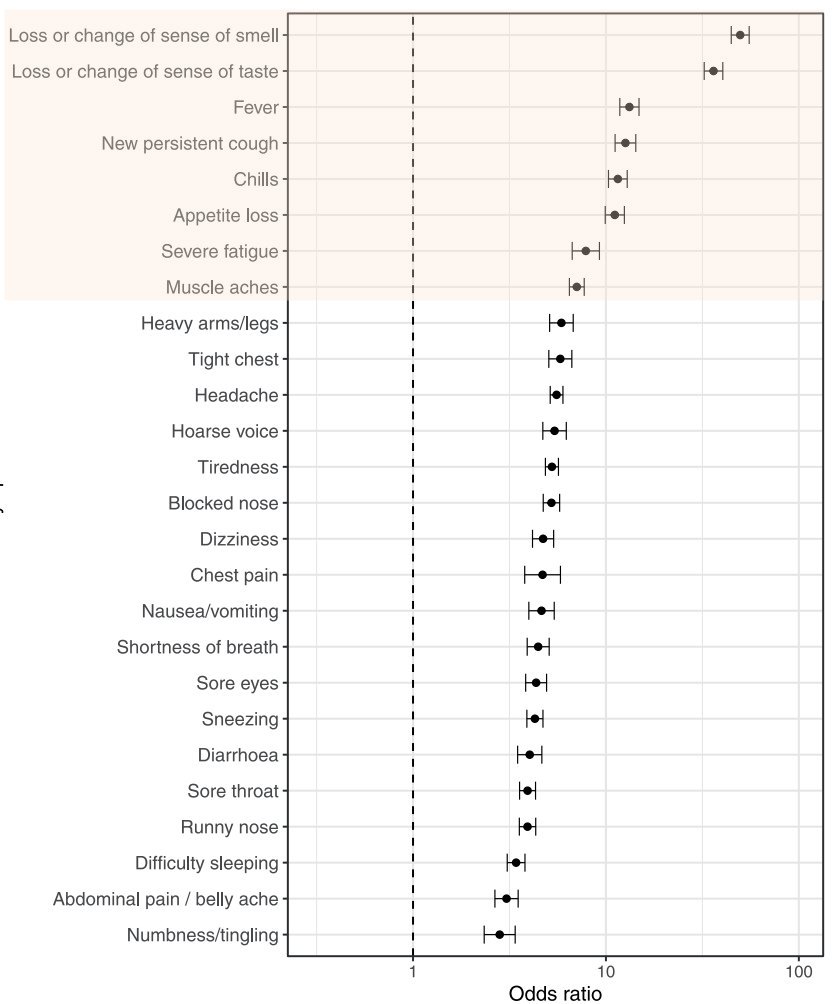7 Symptoms predictive of COVID-19 (from 1,000,000 in UK)
People in the UK were randomly asked to take a COVID-19 test and report on symptoms (if any) in the previous week
Only about 1 in 4,000 tested positive (generally ALPHA ) out of 1 million people
Of those who tested positive, 3X more likely to be asymptomatic rather than symptomatic
Very confusing - I had thought that that asymptomatic = no symptoms - founder of Vitamin D Life
Symptoms recalled in the previous week for those who tested positive
Loss of taste
Loss of smell
Fever
New persistent cough
Chills
Appetite loss
Muscle aches
Symptoms are in priority order
the ones near the top are better indicators of COVID-19 than those near the bottom
Example: having the top 4 symptoms makes the risk of COVID-19 infection
far more likely than if having the bottom 4
Symptoms in chart format from MedScape

"The authors also provide evidence that different variants have different constellations of symptoms, with Alpha having more sore throat, cough, fever, nausea, and vomiting than the wild-type variant."
"Aside from loss of smell and taste, which do seem to be particularly COVID-ish, the symptoms of COVID are just like those of every other respiratory virus, only more so."
Take 200,000 IU of vitamin D at first indiction of symptoms - which could be COVID-19 or another respiratory virus
say just 3 of the above 7 symptoms.
no test needed
Predictive symptoms for COVID-19 in the community: REACT-1 study of overl million people - Sept 28, 2021
PLoS Med 18(9): e1003777. https://doi.org/10.1371/iournal.pmed.1003777
Elliott J, Whitaker M, Bodinier B, Eales O, Riley S, Ward H, et al. (2021)
[email protected] (MCH); [email protected] (PE)
Background
Rapid detection, isolation, and contact tracing of community COVID-19 cases are essential measures to limit the community spread of severe acute respiratory syndrome coronavirus 2 (SARS-CoV-2). We aimed to identify a parsimonious set of symptoms that jointly predict COVID-19 and investigated whether predictive symptoms differ between the B.1.1.7 (Alpha) lineage (predominating as of April 2021 in the US, UK, and elsewhere) and wild type.
Methods and findings
We obtained throat and nose swabs with valid SARS-CoV-2 PCR test results from 1,147,370 volunteers aged 5 years and above (6,450 positive cases) in the REal-time Assessment of Community Transmission-1 (REACT-1) study. This study involved repeated community-based random surveys of prevalence in England (study rounds 2 to 8, June 2020 to January 2021, response rates 22%-27%). Participants were asked about symptoms occurring in the week prior to testing. Viral genome sequencing was carried out for PCR-positive samples with N-gene cycle threshold value < 34 (N =1,079) in round 8 (January 2021). In univariate analysis, all 26 surveyed symptoms were associated with PCR positivity compared with non-symptomatic people. Stability selection (1,000 penalized logistic regression models with 50% subsampling) among people reporting at least 1 symptom identified 7 symptoms as jointly and positively predictive of PCR positivity in rounds 2-7 (June to December 2020): loss or change of sense of smell, loss or change of sense of taste, fever, new persistent cough, chills, appetite loss, and muscle aches. The resulting model (rounds 2-7) predicted PCR positivity in round 8 with area under the curve (AUC) of 0.77. The same 7 symptoms were selected as jointly predictive of B.1.1.7 infection in round 8, although when comparing B.1.1.7 with wild type, new persistent cough and sore throat were more predictive of B.1.1.7 infection while loss or change of sense of smell was more predictive of the wild type. The main limitations of our study are (i) potential participation bias despite random sampling of named individuals from the National Health Service register and weighting designed to achieve a representative sample of the population of England and (ii) the necessary reliance on self-reported symptoms, which may be prone to recall bias and may therefore lead to biased estimates of symptom prevalence in England.
Conclusions
Where testing capacity is limited, it is important to use tests in the most efficient way possible. We identified a set of 7 symptoms that, when considered together, maximize detection of COVID-19 in the community, including infection with the B.1.1.7 lineage.
Why was this study done?
The rapid detection of SARS-CoV-2 infection in the community is key to ensuring efficient control of transmission via isolation.
Eligibility for community PCR testing is determined based on the reported presence of several (predetermined) symptoms, which may vary from one country to another.
Quantitative evidence measuring which symptoms are the most informative of a COVID-19 infection remains scarce.
What did the researchers do and find?
Data were collected from over 1 million participants in the REACT-1 study (June 2020 to January 2021), for whom 26 symptoms were assayed and the results of a PCR test were available.
Adopting a variable selection approach, we sought to determine the best combination of symptoms jointly and complementarity predictive of PCR positivity and investigated whether these symptoms were the same between individuals infected by the wild-type virus and those infected by the B.1.1.7 variant.
We identified 7 symptoms that were jointly predictive of PCR positivity and appeared to vary only marginally across age groups: loss or change of sense of smell, loss or change of sense of taste, fever, new persistent cough, chills, appetite loss, and muscle aches.
These symptoms were also predictive of the B.1.1.7 infection, together with sore throat (to a lesser extent).
Odds Ratios for all of the symptoms

COVID-19 treated by Vitamin D - studies, reports, videos in Vitamin D Life
- {include}
Respiratory virus symptoms
Aching muscles and joints.
Cough and sputum.
Fever.
Headache.
Runny nose.
Sneezing.
Sore throat.
Tiredness
Symptoms - WebMD March 2020 (old)

